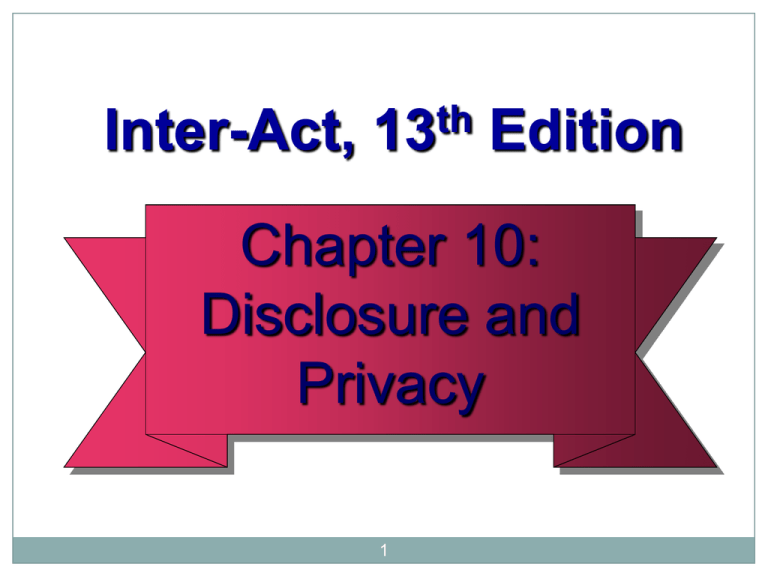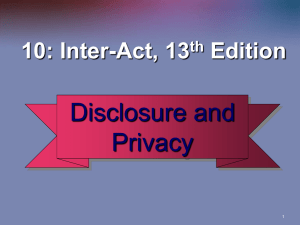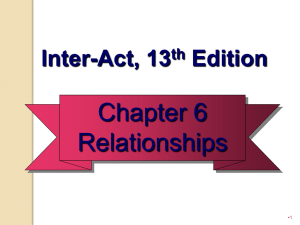Chapter 10 - Bakersfield College
advertisement

Inter-Act, th 13 Edition Chapter 10: Disclosure and Privacy 1 Chapter Objectives 2 Discuss the dialectic of disclosure and privacy Explain the theory of communication privacy management (CPM) List the factors that affect people’s disclosure and privacy rules Explain how disclosure and privacy affect relationships Discuss the effects of technology on privacy boundaries Describe how to give and ask for personal feedback, both praise and constructive criticism Self-Disclosure Privacy 3 Revealing confidential or secret information Withholding personal information to enhance autonomy or minimize vulnerability The Disclosure–Privacy Dialectic 4 The tension between sharing personal information and keeping personal information confidential – also called the openness and closedness dialectic; each person has different expectations; these needs and expectations often vary over time Communication Privacy Management Theory 5 CPM: provides a framework for understanding the decision-making process people use to manage disclosure and privacy Rules designed to maximize benefits of disclosure while minimizing risks We negotiate rules with our partner or we simply assume that our partner understands what rules apply Petronio’s 5 Disclosure Principles 6 1. Private information is “owned” and people believe they have the right to control it. Control is accomplished through privacy rules. 3. When private information is disclosed, the recipient becomes co-owner of the information. 4. Third-party access concerns Permeability: how much can be told Linkage: who else can know Ownership: who makes third-party disclosure 5. We are likely to encounter boundary turbulence, privacy violations, intrusions, and dilemmas. 2. Factors in CPM Theory Rules 7 Culture Individualistic cultures value privacy more than collectivist cultures. Americans tend to disclose more than most cultures. Gender Men tend to disclose less: “strong and silent” type. Women tend to disclose more: “nurturing and sensitive” type. Factors in CPM Theory Rules Motivation Disclose 8 more to people we know or want to know May disclose secrets of those we don’t like Risk–benefit analysis: weigh the advantages/disadvantages of disclosing Context Influenced by circumstances (ex: disclose to a “professional”; may “tell” when one is in danger Disclosure during stress contributes to he Effects on Relationships 9 Intimacy We cycle between periods of deep disclosure and attempts to reestablish privacy boundaries; controls relationship dev. Disclosing secrets may damage/end relationship; opting for privacy may preserve intimacy, avoid conflict, protect feelings. Reciprocity Partners don’t disclose at the same time/rate. Information Co-ownership Disclosing to a third party may damage trust. Families co-own info. and est. rules (personal, legal, financial) 10 Appropriate Self-Disclosure •Self-disclose the kind of information you want others to disclose to you. •Self-disclose more intimate information only when you believe the disclosure represents an acceptable risk. •Continue intimate self- disclosure only if it is reciprocated. •Move self-disclosure to deeper levels gradually. •Reserve intimate or very personal self-disclosure for ongoing relationships. Reciprocal self-disclosure has the greatest positive effects. 11 Skills for Self-Disclosure and Privacy Management 12 Owning Crediting yourself for feelings and opinions Making “I” statements Describing behavior Recounting specific behaviors without drawing conclusions Disclosing feelings Owning and explaining emotions Owning 13 Examples: “Lots of boys wet the bed.”/ “I was a bed wetter.” “Everybody thinks Colin is unfair.”/ “Colin hurt my feelings with his criticism, which I perceived as unfair.” “Nobody likes to be laughed at.”/ “Being laughed at embarrasses me.” “Jon is a flirt.”/ “Jon has been flirting with me.” Describing Behavior 14 Identify the overall impression you are experiencing. Recall the specific behaviors that led to the impression. Form a message to report only what you have seen or heard without drawing a conclusion about the behaviors. Describing Behavior 15 Examples: “I really messed up when I was in high school handing around with gang bangers and generally acting like a tough guy.” (evaluative and vague) “My freshman year in high school I began partying with a local gang. My grades dropped, I was arrested for shoplifting, and I got kicked off the football team. So instead of going to college on an athletic scholarship, I’m working my way through community college.” (specific without drawing conclusions; focuses on the behavior) Describing Feelings Explaining emotions one feels in a precise and unemotional manner 16 Displaying Feelings Showing emotions through facial reactions, body language, or paralanguage Disclosing Feelings 17 Increases the likelihood of having a positive interaction with someone rather than an argument, and it decreases the chances of provoking defensiveness “I feel…” doesn’t guarantee you will end up actually describing a feeling, but may end up evaluating, labeling, or blaming someone Identify what triggered the feelings Identify the particular emotion you are experiencing Use an “I feel..” followed by naming the specific feeling Become comfortable with describing positive feelings before trying to describe negative feelings effectively Protecting Privacy 18 Making a conscious decision to withhold information or feelings from others Change the subject. Mask feelings. Tell a “white lie.” Describe your feelings. Establish personal boundaries. Asking for Feedback 19 Think of feedback as in your best interest. Be prepared for an honest response. Guidelines: Specify the kind of feedback you are seeking. Avoid loaded questions. Try to avoid negative verbal and nonverbal reactions to feedback. Paraphrase what you hear. Show gratitude for the feedback. Giving Personal Feedback 20 Praising Recounting specific behaviors or accomplishments of another and their positive effects on others Constructive Criticism Diplomatically describes the specific negative behaviors of another and their effects Praising 21 When we keep our positive impressions of our partners private, we deprive them of self-concept enhancing info that encourages them to repeat the behaviors we think are praiseworthy Guidelines: Make note of the specific behavior you wish to reinforce Describe the specific behavior Describe the positive feelings or outcomes you or others experienced as a result Phrase your response so that the level of praise appropriately reflects the significance of the behavior Giving Constructive Criticism 22 Begin by asking your partner’s permission to disclose negative feedback. Preface a negative statement with a positive one. Describe the problematic behavior by following guidelines for describing behavior. Be as specific as possible. Suggest how the person can change the behavior. Effects of Social Media on Privacy 23 Social media and cell phone use in public blur the distinction between public and private communication. Social media and the Internet are changing what people view as private and public. Awareness of Audience 24 THE BIG BANG THEORY “THE TANGERINE FACTOR” S1,E17 DISCUSSION: HOW DOES PENNY REACT? HOW WOULD YOU REACT? HOW DOES PERSONAL INFORMATION YOU READ ABOUT FRIENDS ON FACEBOOK IMPACT YOUR PERCEPTION OF THEM? Warranting Theory 25 We use Facebook pages to create perceptions of others: Tags Posts Blog comments Warranting theory: We find behaviors of others more credible when it cannot be easily manipulated by the person whom it describes. Digitally Managing Your Personal Information 26 Do not carry on private phone conversations in public places. Do not post information online that you would not want your employers, enemies, or identity thieves to see. Be aware that others can digitally alter your digital image. Use social media privacy settings. Too much self-disclosure? 27 WHAT IS ON YOUR FACEBOOK ACCOUNT?IN THE WRONG HANDS YOUR FACEBOOK ACCOUNT CAN BE VERY REVEALING. SEE TAKETHISLOLLIPOP.COM How Facebook has changed our conversations 28 WHAT WOULD HAPPEN IF WE USED OUR FACEBOOK LINGO IN OUR FACE-TO-FACE CONVERSATIONS: HTTP://WWW.YOUTUBE.COM/WATCH?V=EGSTKTWXUA







